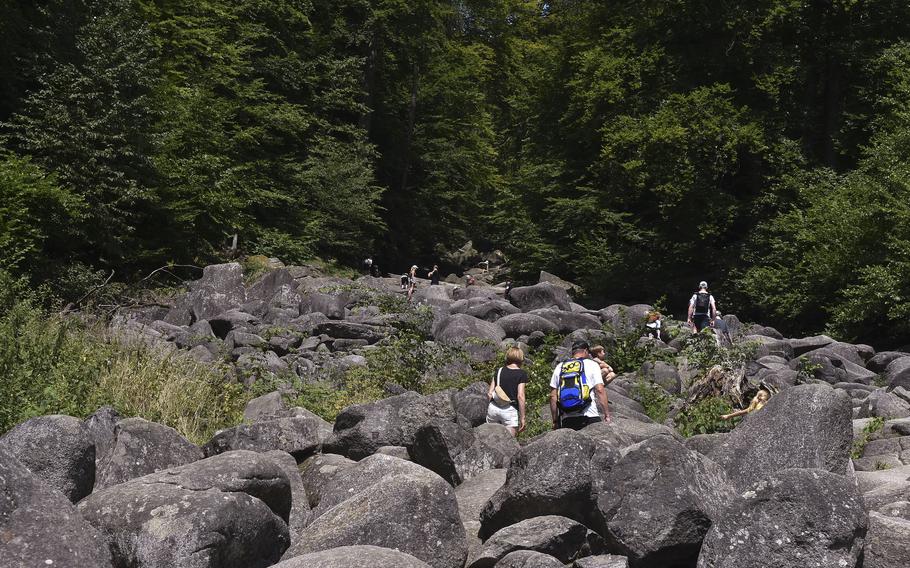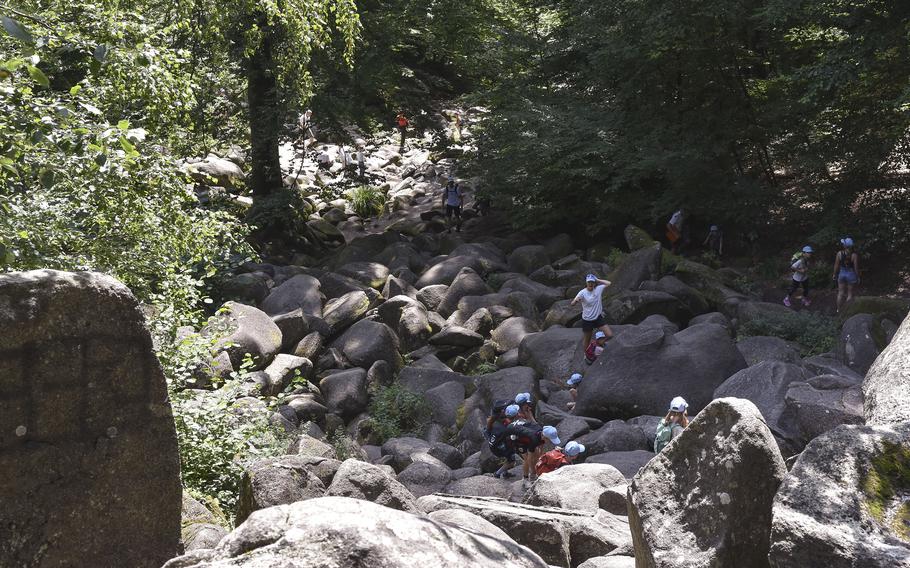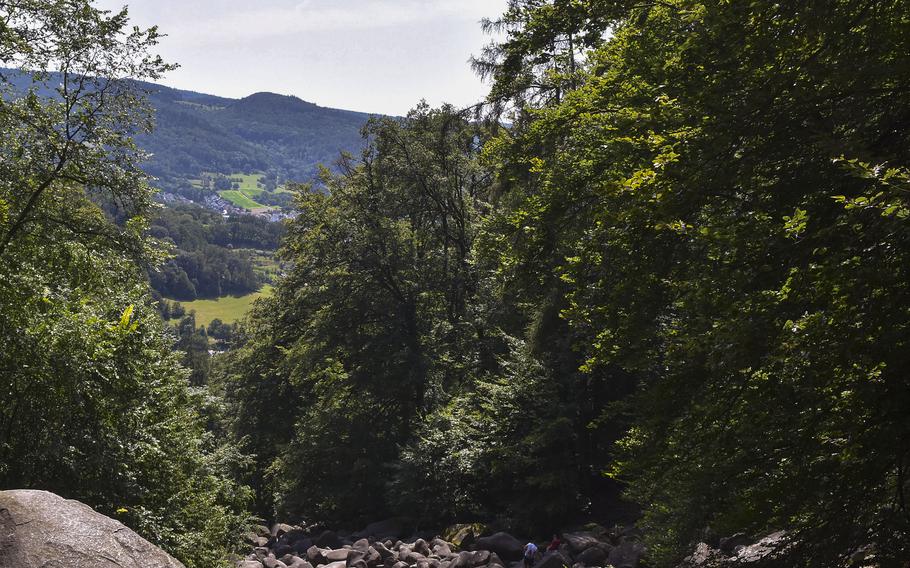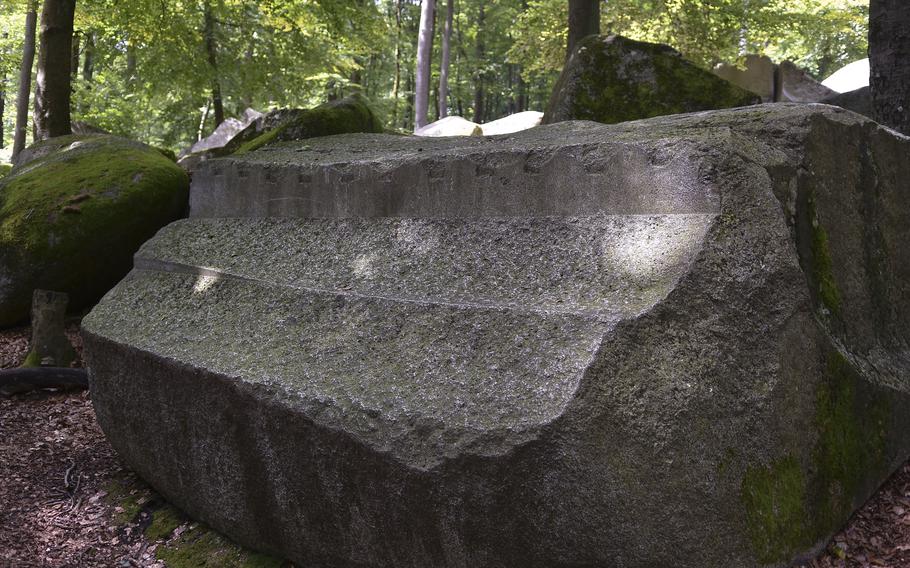
Hikers begin their climb up the Felsenmeer, or "sea of stones," in the Odenwald near Lautertal, Germany, on July 30, 2024. The geological feature stretches a little over a half-mile and climbs over 1,600 feet in elevation. (Bradley Latham/Stars and Stripes)
Local legend around Lautertal, Germany, tells of a sea of stones that formed when two warring giants hurled boulders at one another from opposing mountains, the Felsberg and the Höhenstein.
The former lost the battle and was buried underneath a pile of rocks that tumbled down the mountain to form what is known today as the Felsenmeer.
My teenage son and I didn’t encounter a giant during our recent visit, but the Odenwald Felsenmeer – about an hour drive from Wiesbaden – made for a challenging hike that combined history and myth.
A more rational origin story of the natural wonder involves millions of years of geological processes and erosion that left the mineral-rich boulders in their current positions.

Children climb boulders that make up the Felsenmeer in the Odenwald near Lautertal, Germany. The name Felsenmeer means "sea of stones" in German. (Bradley Latham/Stars and Stripes)
My son was immediately taken aback by the enormous rock formation, which stretched beyond our sight as we stood at the base. He was even more surprised when I told him we were going for a climb.
Visitors young and old can tackle the rocky ascent, which stretches a little over a half-mile and rises more than 1,600 feet, a bit more than the Empire State Building.
The trip up the mountain is a choose-your-own adventure of sorts with numerous paths to the top. Cleared walking trails run alongside the rock formations and divide the climbing area into multiple sections, allowing visitors to rest or opt out of climbing to enjoy a more traditional hiking experience.

The German town of Lautertal is visible in the distance from about halfway up the Felsenmeer, or "sea of stones," in the Odenwald. (Bradley Latham/Stars and Stripes)
The dirt paths can facilitate strollers and wagons with moderate effort but are steep in many places. Families with small children can enjoy navigating the boulders at the lower tiers, but the climb becomes steeper the farther up you go.
Hopping from one boulder to another, we needed to occasionally brace ourselves with our hands after a few questionable jumps.
It’s easy to lose track of how high you’re ascending when you’re focusing on navigating the massive rocks in front of you, and I was astonished by the views below during the couple of breaks we took. In total, it took us about an hour to get to the top.

A kiosk near the top of the Felsenmeer provides refreshments and a resting area for climbers. (Bradley Latham/Stars and Stripes)
There’s a rest area and small snack stand near the top of the trail that usually provides refreshments and a little respite after the climb. It was closed for a weeklong summer break during our visit, but we thankfully had a few snacks with us.
The end of the Felsenmeer lies a couple of hundred feet up from the kiosk, and the boulders are less frequent toward the top.
Aside from the relief and sense of accomplishment we felt, reaching the top of the Felsberg was a bit anti-climactic, as much of our view was blocked by the tall trees in the forested area. The best views came during the climb.

Hikers take a break near the top of the Felsenmeer before descending. (Bradley Latham/Stars and Stripes)
Looking a bit exhausted, my son said he’d consider doing this again when he’s in better shape. Admittedly, the boulder climb took a toll on me as well in the midday sun and 80-degree temperatures.
Along with the path alongside the boulders, a network of other hiking trails offers miles of exploration through other parts of the forest. Hikers can always go back down the way they came, but we decided to take a more leisurely path to the bottom.
Information boards highlight some distinctive stones. We particularly enjoyed the one dubbed the Altar Stone.

The Roman-era Altar Stone rests along a hiking path next to the Felsenmeer in Lautertal, Germany. In the second and third centuries, the Romans used the area as a quarry. (Bradley Latham/Stars and Stripes)
It was enjoyable learning about the Roman stone-cutting techniques used from the second to fourth centuries, when the area was used as a quarry for building materials in the expanding empire.
A snack stand, playground and visitor center sit at the base of the Felsenmeer. The information center has a few displays that provide more details on the rocky formation and Roman history.
It was a nice addition to our trip but far from a highlight, as we spent about 15 minutes in the small display area.
The sea of stones makes for a fun and sometimes challenging excursion that sparks imagination and provides a connection to the past. Dogs are also allowed if they’re on a leash.

The Crocodile Stone is one of a handful of highlighted geological features along the hiking trails next to the Felsenmeer near Lautertal, Germany. (Bradley Latham/Stars and Stripes)
Odenwald Felsenmeer
Address: Felsenmeer 3, Lautertal, Germany
Hours: Open year-round; for the information center, through Aug. 25, 10 a.m.- 5 p.m. Monday-Sunday; Aug. 26-Oct. 31, 11a.m.- 4 p.m. Wednesday-Friday; Saturday and Sunday, 10 a.m.-5 p.m.
Cost: 5 euros for parking
Information: Phone: +49 6254940160; Online: felsenmeer-zentrum.de